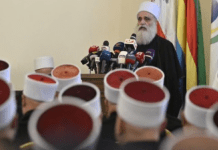Hezbollah has some 2,000 unmanned aerial vehicles – ALMA
Anna Ahronheim/Jerusalem Post/December 23/2021
جيروزاليم بوست: حزب الله يمتلك حوالي 2000 طائرة بدون طيار
القناة 23 /23 كانون الأول/2021
كشفت صحيفة ”جيروزاليم بوست“ العبرية، اليوم الأربعاء، عن امتلاك حزب الله اللبناني حوالي 2000 طائرة بدون طيار، بعضها مطورة في إيران، وأخرى مصنعة بشكل مستقل من قبل الحزب، بعد أن نقلت طهران إليه تقنياتها. وقالت الصحيفة في إصدارها باللغة الإنجليزية، نقلاً عن تقرير صادر عن مركز ”ألما“ للأبحاث والتعليم الإسرائيلي، إن ”حزب الله اللبناني يمتلك حوالي 2000 طائرة بدون طيار، يستخدمها منذ التسعينيات، واستخدم بعضها في سوريا، وكذلك ضد إسرائيل“. وتقول الصحيفة إنه ”حتى قبل حرب لبنان الثانية في عام 2006، أطلق الحزب طائرات بدون طيار على إسرائيل، وأثناء الحرب أطلق حزب الله كذلك عدة طائرات قتالية بدون طيار على البلاد“. وأكدت الصحيفة أن حزب الله أطلق طائرات بدون طيار على إسرائيل في تشرين الأول/ أكتوبر 2012، حيث وصلت هذه الطائرات إلى منطقة النقب في إسرائيل قبل أن تعترضها طائرات سلاح الجو الإسرائيلي. وأوضحت الصحيفة أنه ”كان لدى حزب الله 200 طائرة بدون طيار إيرانية الصنع في عام 2013، لكن بمساعدة من إيران، قامت منذ ذلك الحين بزيادة أعدادها بشكل كبير“. ووفق الصحيفة، سيستخدم الحزب هذه الطائرات بدون طيار، مثل ما فعله ”الكاميكازي“، في هجمات على أهداف استراتيجية تابعة للجيش الإسرائيلي.
وأضاف التقرير: ”طور حزب الله نماذج متطورة من الطائرات بدون طيار مثل ”مهاجر“ وشاهد وصامد“ (KAS-04) وكرار وصاغة، بالإضافة إلى امتلاكها العشرات من الطائرات بدون طيار المدنية الأصغر التي تصنعها الصين، والتي تُستخدم لتصوير وحمل وإلقاء القنابل“.
وتطرقت الصحيفة إلى بناء إيران جيش الطائرات بدون طيار، منذ عام 1984، مشيرة إلى أن هذه الطائرات تتمتع بقدرات متطورة، وعمليات تشغيلية متقدمة للغاية“. وأردفت الصحيفة أن إيران أدركت أنها لا تستطيع تقديم رد عسكري في جميع أنحاء الشرق الأوسط بشكل عام، وضد إسرائيل بشكل خاص، لذلك سعت إلى تطوير بديلين في العقود الأخيرة، الأول يتمثل بنظام صاروخي دقيق أرض- أرض، والثاني جيش من الطائرات بدون طيار. وعلى الرغم من أن إيران لديها مئات الطائرات بدون طيار، فقد سلط التقرير الضوء على 9 أنواع مختلفة منها و 48 نموذجًا مختلفًا، بما في ذلك تلك العاملة والأخرى التي لا تزال في مراحل التجربة. وناقش التقرير كذلك نماذج الطائرات بدون طيار التي يستخدمها حزب الله وحركة حماس والجهاد الإسلامي الفلسطيني في قطاع غزة. وكان وزير الدفاع بني غانتس قد قال، في سبتمبر الماضي، إن ”أسطول الطائرات بدون طيار هو أحد أهم الأدوات التي طورتها إيران، هي مجموعة من الأسلحة الفتاكة والدقيقة، مثل الصواريخ الباليستية أو الطائرات، يمكنها عبور آلاف الأميال“. وتقول الصحيفة العبرية إن ”الإيرانيين ينتجون ويصدرون هذه الطائرات لوكلائهم بالتنسيق مع قيادة سلاح الجو، وفيلق القدس التابع للحرس الثوري الإيراني“.
وبحسب غانتس، ”تقوم إيران بتدريب ميليشيات من العراق واليمن ولبنان وسوريا على تشغيل وتصنيع طائرات بدون طيار إيرانية في قاعدة كاشان شمال مدينة أصفهان، حجر الزاوية للإرهاب الجوي الإيراني في المنطقة“، على حد وصفه.
ولفتت الصحيفة إلى أنه ”بالإضافة إلى كاشان، أشار التقرير إلى أكثر من 20 قاعدة إضافية للإنتاج والتخزين والإطلاق تستخدمها إيران لإطلاق طائرات بدون طيار في إيران والعراق وسوريا ولبنان“.وبالإضافة إلى عشرات القواعد في إيران، يستخدم فيلق القدس التابع للحرس الثوري الإيراني أيضًا قاعدة بالقرب من مدينة كربلاء العراقية إلى جانب حزب الله العراقي. وتقول الصحيفة إن حزب الله والحرس الثوري الإيراني وميليشيات شيعية أخرى في سوريا تنشط باستخدام القواعد الجوية على الأقل؛ لشن هجمات الطائرات بدون طيار.
وأشارت الصحيفة إلى أن حزب الله يمتلك موقعاً لإطلاق هذه الطائرات بالقرب من بلدة عيات في سهل البقاع، بالإضافة إلى مدرج آخر بطول عدة مئات الأمتار شمال بلدة عيات في ضواحي بعلبك. وتحدث غانتس في سبتمبر أيضاً عن إحدى الأدوات الرئيسية لدى حزب الله وإيران، وهي الطائرات بدون طيار والأسلحة الدقيقة، التي يمكن أن تصل إلى أهداف استراتيجية في نطاق آلاف الكيلومترات. من جهة أخرى، تطرق التقرير إلى تصميم إيران أيضًا طائرات بدون طيار قادرة على العمل في سرب يضم أكثر من 10 طائرات بدون طيار. وبحسب التقرير، فقد طورت إيران هذه برأس حربي قتالي يتراوح وزنه بين 5 و15 كيلوغراماً، وبمدى تشغيلي يصل إلى 400 كلم.
Hezbollah has some 2,000 unmanned aerial vehicles – ALMA
Anna Ahronheim/Jerusalem Post/December 23/2021
Hezbollah had 200 Iranian-made UAVs in 2013 and has since significantly increased its fleet.
Hezbollah has some 2,000 unmanned aerial vehicles, many of them advanced UAVs from Iran and others manufactured independently by the Lebanese terrorist group, a new report by the ALMA Research Center has found.
Hezbollah has been using UAVs since the 1990s and has used its drones in Syria as well as against Israel. Even before the Second Lebanon War in 2006, the group launched drones into Israel; and during the war, Hezbollah launched several armed drones into the country.
The report by ALMA listed several attempts by Hezbollah to fly its drones into Israel, including in October 2012 when a UAV launched over the Mediterranean Sea reached the Negev before it was intercepted by Israel Air Force jets.
The group was said to have 200 Iranian-made UAVs in 2013; and with help from the Islamic Republic, it has since significantly increased its fleet, which is set to be used for kamikaze attacks on strategic national assets in Israel as well as reconnaissance against IDF troops and bases.
According to the report, Hezbollah “most likely” has advanced UAV models such as the Mohajer, Shahed, and Samed (KAS-04), Karrar and Saegheh types. It also possesses dozens of smaller civilian drones made by China that are used to photograph as well as to carry and drop bombs.
Iran has been building its “UAV Army” since 1984, and the fleet not only has a significant range of over 2,000 kilometers but it has “very advanced development and operational capabilities,” the report said.
“Iran realized that it could not provide a military response throughout the Middle East in general and against Israel in particular, facing an air force operating warplanes. Therefore, it sought to develop two alternatives in recent decades: the first, a precision surface-to-surface missile system, and the second, a ‘UAV Army.’”Though Iran has thousands of drones, the report highlighted nine types of UAVs and 48 models, including those that are operational and others that are still in trial phases. The report also discussed UAV models used by Hezbollah, Hamas and Palestinian Islamic Jihad in the Gaza Strip.
In September 2021, Defense Minister Benny Gantz said that Iran’s drone fleet “is one of the most significant tools developed by Iran.”
It’s “an array of deadly, precision weapons that, like a ballistic missile or a plane, can cross thousands of miles. The Iranians produce and export these aircraft to their proxies, in coordination with and led by the IRGC Air Force and Quds Force.”
According to Gantz, Iran is training militias from Iraq, Yemen, Lebanon and Syria to operate and manufacture Iranian UAVs at Kashan Base north of the city of Isfahan, “the cornerstone of Iranian aerial terrorism in the region.”
In addition to Kashan, the report noted more than 20 production, storage and launch sites used by Iran to launch drones from Iran, Iraq, Syria and Lebanon.
The report included Konarak Civil Airport, located east of the city of Chabahar in southern Iran, Bandar Abbas Airport, Choghadak Airfield, Gonabad Airfield, Hamedan Air Base, Jakigur Airport, Jask Airport, Kushke Airport, Marjan Airstrip, Minab Airstrip and Seman Airport.
As well as its dozens of bases in the Islamic Republic, Iran’s Revolutionary Guard Corps Quds Force uses a base near the Iraqi city of Karabala alongside Iraqi Hezbollah.
Hezbollah, the IRGC and other Shi’ite militias are also active in Syria, using several air bases to launch UAV attacks.
In Lebanon, Hezbollah has a launch site near the town of Aiiyat in the Beqaa Valley, as well as another runway several hundred meters long north of the town of Aiiyat on the outskirts of Baalbek.
“One of the key tools is UAVs and precision weapons, which can reach strategic targets within thousands of kilometers, and thus this capability is already endangering Sunni countries, international troops in the Middle East and also countries in Europe and Africa,” the defense minister said in September.
“Iran has created ‘emissary terrorism’ under the auspices of organized terror armies that help it achieve its economic, political and military goals. Iran is trying to transfer its knowledge that will enable Iraq, Syria, Lebanon and Gaza to produce advanced UAVs,” he added.
Tehran also attempted to send explosives to Palestinian terrorists in the West Bank from Syria using unmanned aerial vehicles, Gantz said.
The attempt to smuggle explosives, attached to a Shahed m141 UAV, occurred in February 2018; and while the IDF had originally said the drone was on its way to carry out a sabotage attack, “its destination was, to our understanding, terrorists in the West Bank.
“Iran is not only using unmanned aerial vehicles to attack but also to transfer weapons to its proxies,” he warned.
The Islamic Republic has designed UAVs capable of operating in a swarm, 10 or more drones. Unveiled in April, Iran developed a drone with a combat warhead weighing between 5 kg. and 15 kg. with an operational range of 400 km.
A drone and missile swarm by Iran was first used in September 2019 against Saudi Arabia’s Aramco oil processing facility in Abqaiq, some 1,000 kilometers from where the drones were launched. The attack disrupted the kingdom’s ability to produce oil for months and alerted the international community to the threat posed by Iran’s drone arsenal. Iran has since carried out several more drone attacks, including the deadly attack on the MT Mercer Street that killed the British captain and Romanian security guard.






















